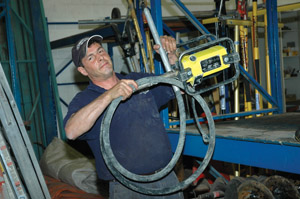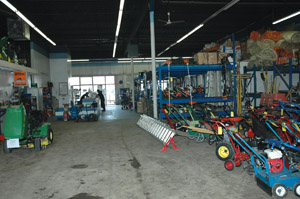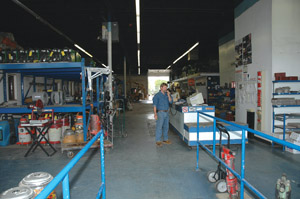
Profile: Meeting the challenge of a booming market
By Chris Skalkos
Features ProfilesThe first time Dan McFetridge heard about the rental industry was in 1989 after reading a help wanted advertisement in a newspaper. “I never heard of a rental store before in my life until I saw the ad,” he says.
 |
| Dan McFetridge is the owner of Snowbird Rentals, which operates three branches in Edmonton, Alta. |
The first time Dan McFetridge heard about the rental industry was in 1989 after reading a help wanted advertisement in a newspaper. “I never heard of a rental store before in my life until I saw the ad,” he says.
As a young 18 year old, McFetridge, who is originally from Kentville, N.S., was vacationing in Alberta and decided to stay to take advantage of better employment opportunities, first working at the Calgary stampede and then for the oil industry. Looking for a change, he responded to the advertisement and met Richard Taylor, the owner of Snowbird Rentals in Edmonton, who hired him.
The company Taylor started in 1977 out of a hobby had grown to include two branches by 1979 and McFetridge, who had some small engine repair and
landscaping experience, began working for this rental company cleaning equipment.
The business kept growing opening another branch in 1995. McFetridge was growing with it, progressing through all the levels from delivery driver to operations manager before buying into the business in 1997 and becoming a partner. In 2005 he became full owner as Taylor retired from the industry, 16 years after hiring him.
 |
| Greg Tantrum supervises the company’s south side branch. |
 |
| Mechanics Bernie Patrick and Patrick London ‘senior’, double-team the maintenance work on a trencher. The two share a vivid sense of humour while working together and refused to disclose which one was the ‘senior’ of the two. |
 |
| Dave Rayburn brings in a John Deere lawn tractor for repairs. |
 |
| Rob Bauset retrieves a rental item for a customer. |
In that time Edmonton grew dramatically as western Canada was experiencing an incredible economic upswing. Taylor took over the business just as the economic boom was starting to hit and has witnessed an incredible amount of growth in the city which has kept his rental operation busy. “It peaked in 2007 and now it’s starting to level off but the housing market is still strong.”
In 2004 and 2005, Alberta’s real economic growth was above five per cent, more than two percentage points higher than national figures. Economic growth hit six per cent in 2006, roughly three times higher than the rest of Canada driven by the high price of crude oil and massive development in the oil sands.
McFetridge says the impact of this fast growing economy on his business was immediate. “We were able to start buying bigger equipment. “Before that we carried mostly small tools and equipment. The boom really took off fast and that really pushed a lot of new equipment into the market.”
Winters, which were traditionally the slowest time of year suddenly picked up as demand for heaters spiked. “We suddenly saw a volume increase so we increased our line of Patron heaters. Electric heaters became popular when the cost of fuel went up. These are clean and efficient, high output heaters that push 30,000 BTUs producing dry clean heat that drywall contractors love,” he says, adding that they are ideal for contractors working on small housing and condominium developments. “I bought 55 of these units, and I think over the last two years I was Patron’s number one customer for heater sales,” he says with a chuckle.
The sheer volume of heater rentals the company was doing was enough to fill the down-time it usually experienced during the winter. “We do our bulk of buying during the winter and now with heaters being so active we aren’t slow anymore but it’s not too hectic so we can still do maintenance.”
In the summer the company mostly rents skidsteers, trenchers, sod cutters, lawn and garden tools. It services mostly homeowners and small contractors, but its contractor base of customers is growing to represent almost half of the company’s business.
However, the economic boom has posed its own challenges as the costs of operating the business have also risen. “Everything has increased. After prices went up we had to increase some of our rental rates, but the biggest impact for us is the cost of fuel,” he says adding that the demand for delivery and pick-ups, have also increased dramatically since 1997.
With the cost of fuel at the pumps escalating McFetridge says charging for delivery becomes even that much more important. “We never drop delivery charges unless it’s for a very good customer who needs something small just four blocks away. But if I have to load up the truck with a skidsteer and drive downtown the delivery charge is $85 one way.”
Another challenge he had to face was the shortage of labour in the employment market which has affected every industry in the province. Alberta’s labour market is tight as the province has the country’s lowest proportion of jobless and the highest proportion of workers. Employment has been skyrocketing, prompted by province’s booming oil and gas and construction sectors. In 2006 the number of jobs in Alberta climbed six per cent, almost three times the national average and the unemployment rate averaged just 3.4 per cent.
 |
| By design the company’s open shop layout allows an open view from the front door all the way to the back so customers can see everything it carries. |

|
The employment growth also brought on wage increases. The average hourly wage rose 6.9 per cent in 2006, more than double the 2.6 per cent rise seen across Canada. Alberta’s hourly wage rate, $21.62 an hour, was the highest in the country while having the lowest proportion of workers earning minimum wage or less at just 1.7 per cent. McFetridge says in this type of a labour market it is difficult to retain employees. “I have lost workers to the oil patch and bigger rental companies. I offer my staff a good wage with a bonus structure, but even that’s not enough of an incentive to keep them compared to what other companies are offering,” he says.
All he can do is keep his 15 employees happy by providing them with a good working environment.
“When they are driving to a delivery I tell them never rush, even if they’re running late. That takes a lot of the stress off of them. I would rather see them get there safely and not be stressed out trying to rush,” he says, adding that he has also had to change his store hours. “We used to be open seven days a week, but I decided to close on Sundays as a way to ease the stress of trying to staff the store and ensure that the guys have a day off.”
Even though labour is at a premium and service work could be piling up in the shop McFetridge says cutting corners on maintenance to get equipment out the door is never an option in this business as picking up disabled equipment from a jobsite and finding a replacement can cost even more time.
“Keeping up with maintenance is given, but the next important step is the equipment’s appearance,” he says emphasizing that the simple act of cleaning the equipment should not be underestimated.
He says if you look at most equipment on a job site you can tell which ones the contractor owns and which ones are from a rental store, even between two units that are the same age. “The impression is dramatic. If they get the equipment clean they seem to treat it better and believe it or not they even think it works better.”
Although the economy in Alberta has been showing signs of slowing down new subdivisions are still going up and this is sector of the market is one of his busiest. “There was a large number of homes sold last year. They need to have landscaping and renovations completed within a year so there is a rush for related equipment.”
In such an economic climate it is tempting to invest more into equipment, however; McFetridge says that he is still making equipment purchases conservatively, for Alberta standards. “We will expand a little more into skidsteers, add a line of John Deere lawn tractors and we just bought six jumping jacks from Dynapac. They are phenomenal machines, easy to operate and easy to service. They have smaller plates too.”
While he plans to expand further into larger earth moving equipment he says that he has no plans to compete with his much larger competitors such as United Rentals, Hertz and Cat Rents. “What they do is not feasible for my rental operation and I don’t want to get into it because the markets I serve right now are resilient.”
McFetridge says he keeps a good relationship with the other rental companies in Edmonton, as well as with the employees of rental departments in big box stores; partly because there is enough work to go around in this still vibrant economy, but also because many of his competitors use to be employees of Snowbird Rentals. “I see lot of ex-employees working at other rental stores,” he says, with a laugh, adding that one of them was an ex-manager who quit to work at another rental company just a few weeks before Canadian Rental Service magazine
visited the company.
“I’m proud to look back and count how many people started here and have since moved up in the rental industry. A lot of success stories have come out of this company.”
Without a doubt, McFetridge is also one of them.
Print this page
Leave a Reply